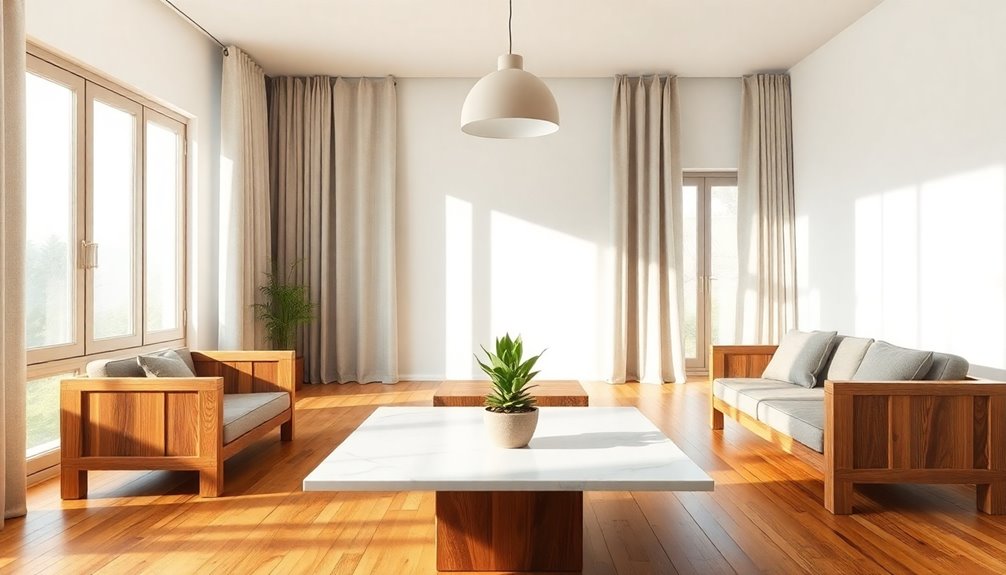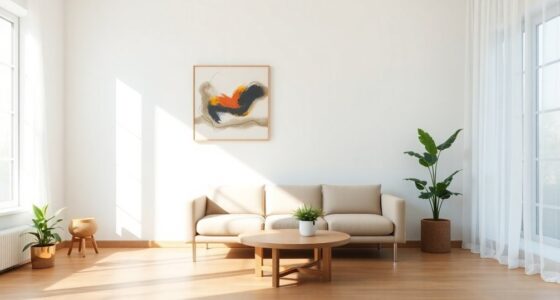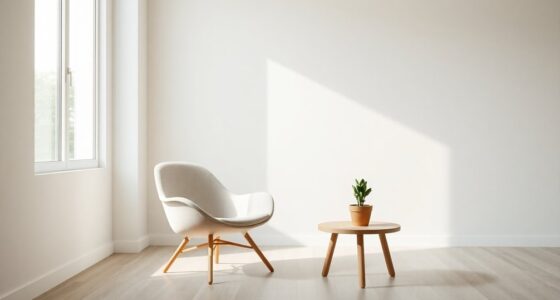Minimalism meets sustainability through eco-friendly design trends that focus on simplicity and functionality. With a commitment to reducing waste, you can embrace streamlined packaging, durable materials, and multifunctional items that promote conscious consumption. Natural elements like bamboo and reclaimed wood add warmth while enhancing tranquility in your space. By prioritizing quality over quantity, you contribute to a healthier planet. Discover how these principles can transform your lifestyle for a more sustainable future as you explore further.
Key Takeaways
- Minimalist design prioritizes resource efficiency, reducing waste and promoting eco-friendly practices in everyday living.
- Emphasis on multifunctional and adaptable designs minimizes the quantity of items needed, fostering sustainability.
- Natural materials like bamboo and reclaimed wood enhance aesthetic appeal while ensuring ecological responsibility.
- Streamlined packaging solutions, such as biodegradable and compostable options, lower environmental impact and shipping costs.
- Future trends include smart packaging and regulatory shifts, promoting consumer engagement and commitment to sustainable practices.
The Intersection of Minimalism and Sustainability
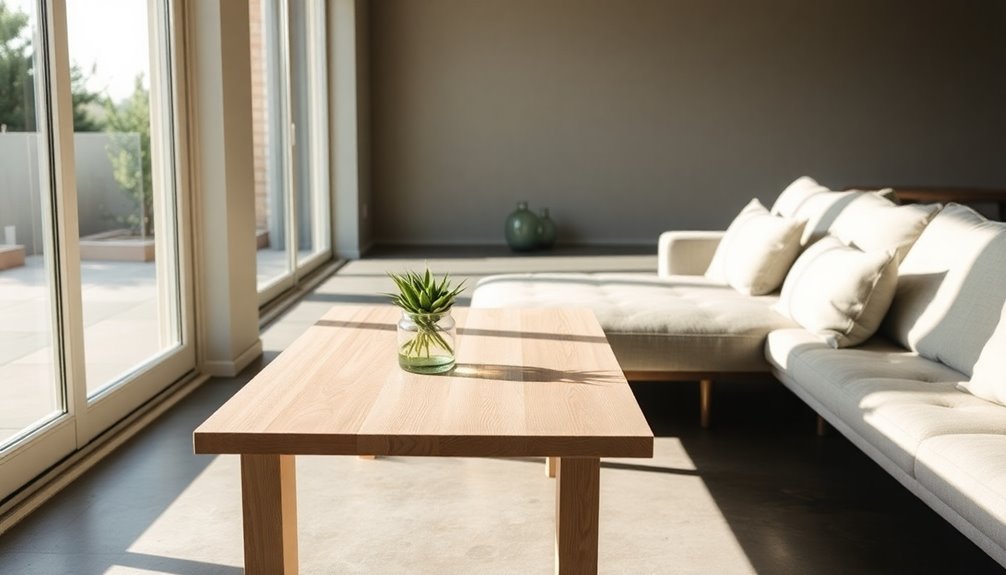
As you explore the intersection of minimalism and sustainability, you'll find that these two concepts harmoniously blend to create designs that are both aesthetically pleasing and environmentally friendly.
Minimalist design prioritizes simplicity and functionality, allowing for thoughtful resource use that considerably reduces environmental impact. You'll notice how minimalist packaging solutions often utilize biodegradable and recyclable materials, aligning perfectly with consumer demand for eco-friendly products.
Minimalist design emphasizes simplicity and functionality, significantly reducing environmental impact through thoughtful resource use and eco-friendly packaging solutions.
By embracing durable, reusable items made from sustainable materials, you contribute to a circular economy and help decrease landfill waste.
Additionally, the integration of natural materials and calming color palettes in minimalist design fosters a deeper connection with the environment, promoting not just ecological responsibility, but also enhancing your mental well-being. Incorporating natural materials into your decor can create a more harmonious living space that reflects both aesthetic and sustainable values.
Benefits of Minimalist Design in Eco-Friendly Living
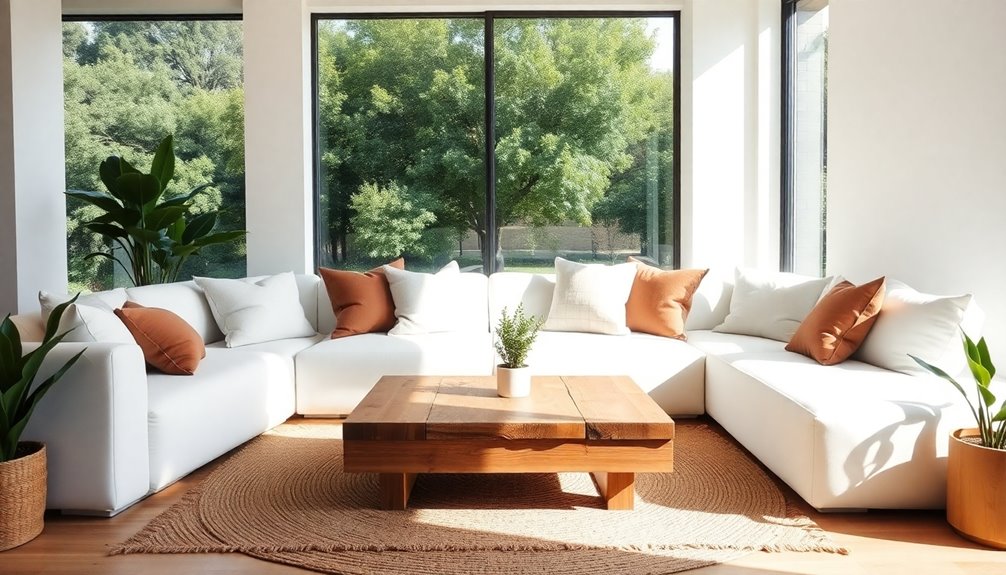
Embracing minimalist design can lead to a profound sense of clarity and purpose in eco-friendly living. By reducing material usage, you not only lighten your packaging but also lower shipping costs and transportation emissions, benefiting the environment.
A minimalist lifestyle prioritizes quality over quantity, encouraging conscious consumption that cuts down on waste and frequent replacements. With furnishings that feature clean lines and streamlined designs, your space becomes uncluttered, enhancing your mental well-being and fostering tranquility.
Additionally, focusing on multifunctional and versatile designs optimizes space, minimizing the number of items you need. Integrating eco-friendly materials adds warmth and authenticity to your environment while supporting sustainability, creating a harmonious blend of minimalist and sustainable living that truly resonates. For example, the innovative approach of Builder Mikes Bright Tiny House demonstrates how smart technology and sustainable materials can enhance both space efficiency and aesthetic appeal.
Key Principles of Sustainable Minimalism
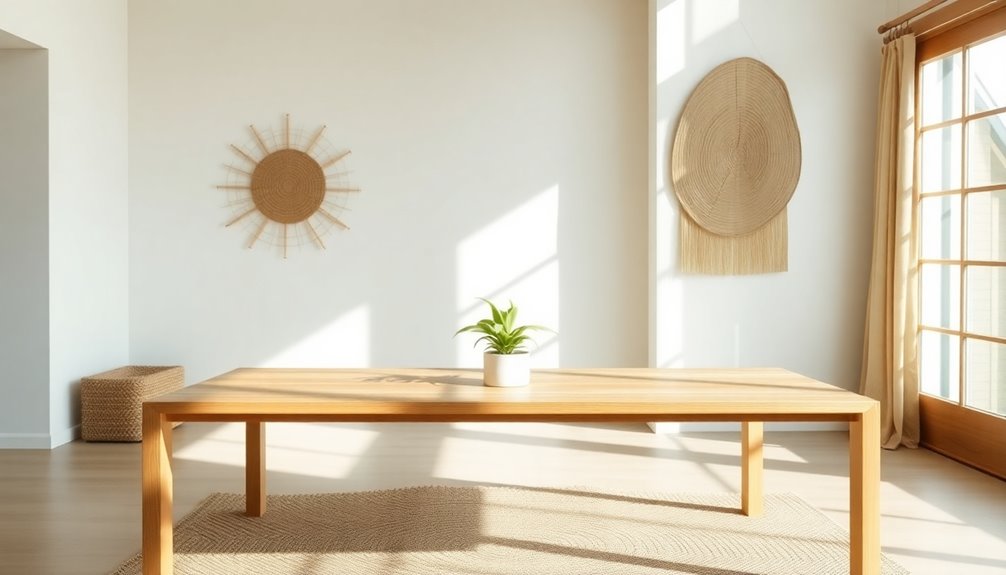
When you embrace sustainable minimalism, you focus on resource efficiency and timeless design aesthetics. This means choosing durable, multifunctional items that not only look good but also reduce waste and energy use. Incorporating elements like renewable energy sources can further enhance the sustainability of your design choices.
Resource Efficiency Focus
Sustainable minimalism prioritizes resource efficiency by emphasizing quality over quantity, so you can reduce waste and minimize the need for replacements.
By adopting minimalist principles, you embrace sustainable practices that enhance longevity and promote easier recycling.
Streamlined designs in packaging require fewer materials, resulting in lighter, compact options that lower shipping costs and transportation emissions.
This resource efficiency focus not only cuts down on excess items but also encourages multifunctional and adaptable designs in furniture and products.
Rethinking functionality helps you align with eco-responsibility expectations while decreasing your environmental footprint. Additionally, incorporating mindfulness techniques can help reinforce your commitment to sustainable choices in everyday life.
Timeless Design Aesthetics
Resource efficiency not only reduces waste but also sets the stage for timeless design aesthetics in sustainable minimalism. By focusing on natural materials like bamboo and reclaimed wood, you create authentic spaces that promote environmental harmony. A calming color palette with soft earthy hues fosters a serene atmosphere, enhancing your mental well-being. Embracing multi-functional furniture allows for versatility in your living spaces, aligning with both minimalist and sustainable principles.
| Elements | Benefits |
|---|---|
| Minimalist Furnishings | Streamlined and functional |
| Textural Contrasts | Invites relaxation |
| High-Quality Materials | Guarantees longevity |
Emphasizing simplistic and multifunctional design styles allows you to incorporate adaptable furniture that aligns with eco-friendly principles. This thoughtful approach guarantees that your interiors remain timeless while contributing to sustainable design.
Inspiring Examples of Minimalist and Sustainable Design
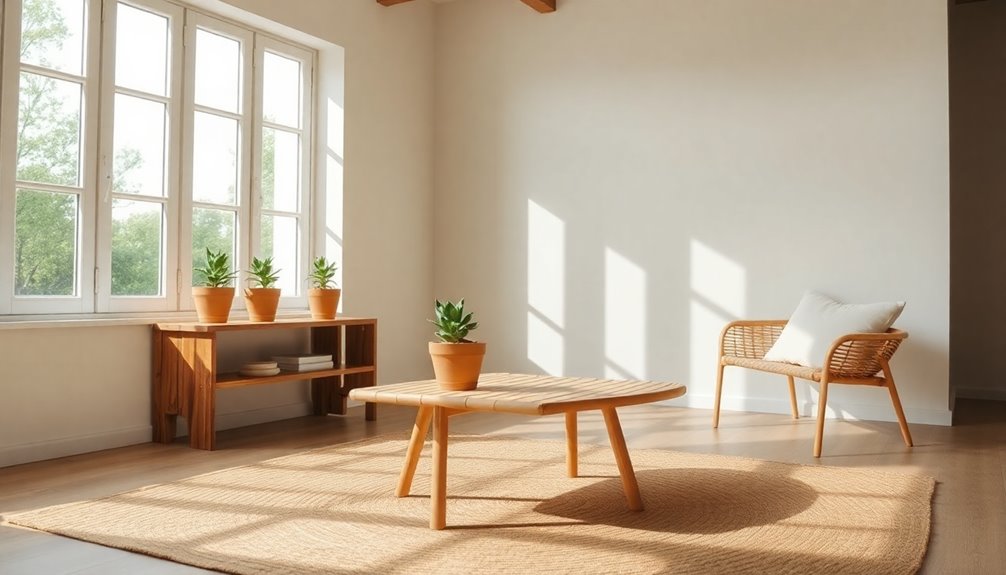
Embracing minimalist and sustainable design can transform your space into a harmonious retreat that reflects both style and environmental consciousness.
Take the Eco Low Profile Cap, for example; its minimalist design reduces material usage while ensuring functionality, highlighting how thoughtful design can enhance user experience.
In the packaging industry, many brands are shifting towards eco-friendly solutions, utilizing biodegradable and compostable materials.
Streamlined packaging not only lowers shipping costs but also minimizes environmental impact.
Additionally, innovative furniture crafted from sustainable materials like reclaimed wood and bamboo showcases how minimalist design can combine aesthetics with functionality, promoting longevity and reducing waste.
These inspiring examples illustrate that you can create a beautiful, eco-conscious environment without compromising on style. Furthermore, integrating high-end materials into your design can elevate both the aesthetic and sustainability of your space.
The Role of Natural Materials in Minimalist Spaces
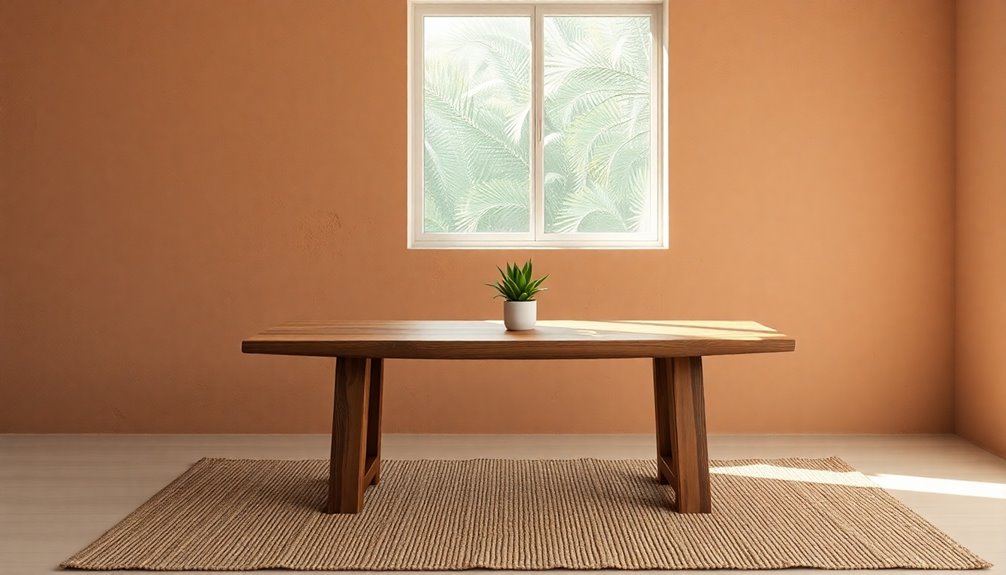
As you create a minimalist space, incorporating natural materials like bamboo, reclaimed wood, and recycled glass can markedly enhance both the aesthetic and sustainable aspects of your design. These materials not only promote sustainability but also contribute to a warm, inviting atmosphere. By selecting high-quality, sustainably sourced options, you reduce your environmental footprint while ensuring durability. Additionally, integrating wood stove decor can enhance the warmth of the space, adding both functionality and charm.
| Material | Sustainability | Aesthetic Appeal |
|---|---|---|
| Bamboo | Highly renewable | Sleek and modern |
| Reclaimed Wood | Reduces waste | Rustic charm |
| Recycled Glass | Energy-saving | Elegant translucence |
| Natural Fabrics | Biodegradable | Soft textures |
| Stone | Long-lasting | Timeless beauty |
Thoughtful integration of these elements fosters harmony with nature, enhancing your minimalist design's authenticity.
Color Palettes That Enhance Eco-Friendly Aesthetics
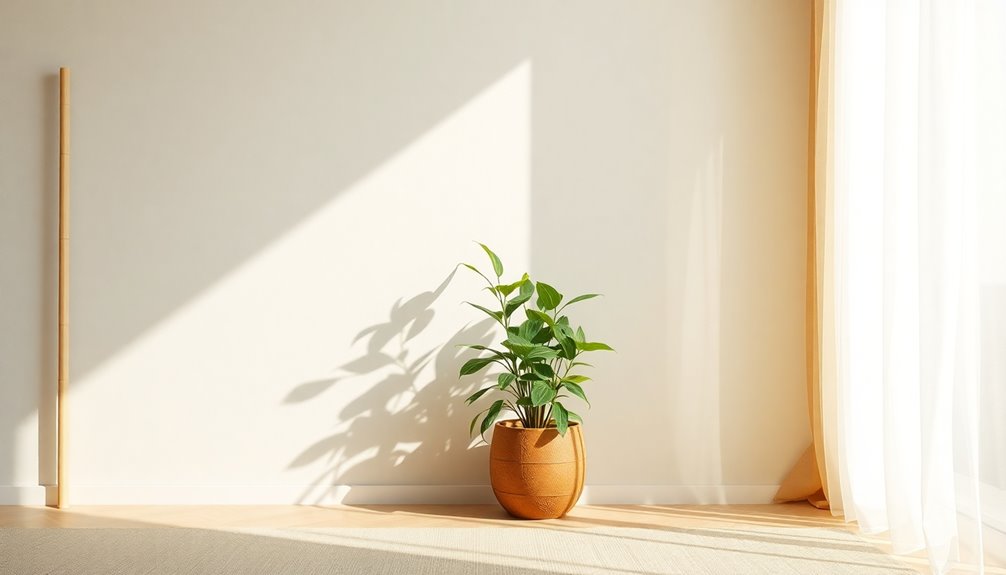
When designing eco-friendly spaces, choosing the right color palette can greatly enhance your minimalist aesthetic. Soft earthy hues like beige, taupe, and olive create a calming backdrop that connects your interiors with nature, reinforcing eco-friendly aesthetics.
A monochromatic color scheme using understated tones promotes tranquility and allows natural materials to shine, embodying a sustainable approach. Incorporating cool shades of blue adds serenity, while warm textures create a balanced atmosphere.
Minimalist color palettes emphasize simplicity, fostering timeless elegance that reduces visual clutter. By thoughtfully integrating color and texture, you not only elevate the visual appeal of your space but also align with sustainable living principles, focusing on quality over quantity. Innovative interior design can further enhance the effectiveness of these color choices in achieving a cohesive look.
Embrace these palettes to cultivate a harmonious environment.
Practical Tips for Implementing Minimalist Sustainability
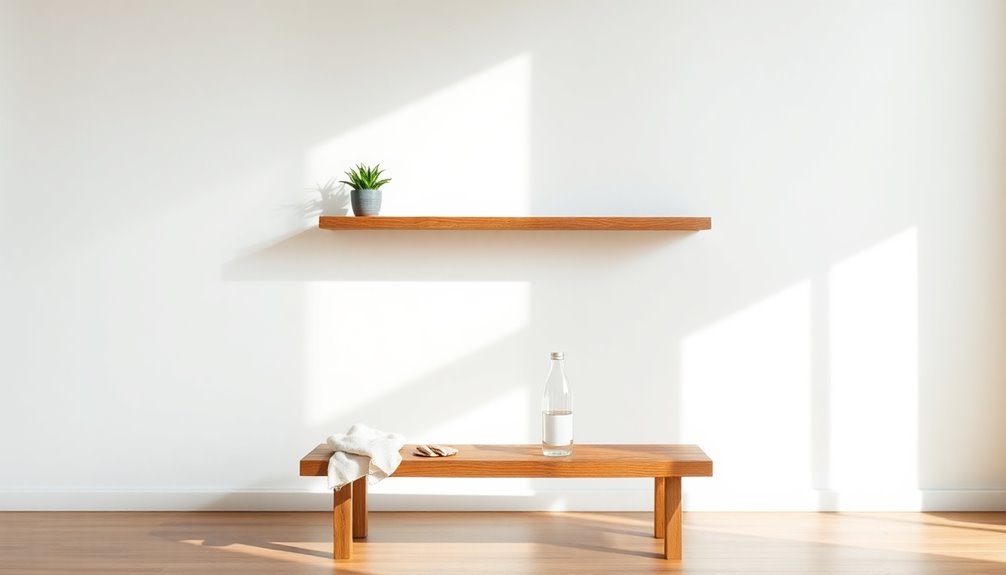
To implement minimalist sustainability effectively, focus on selecting furniture and decor crafted from sustainable materials like bamboo or reclaimed wood. These choices not only elevate your design but also reduce environmental impact through responsible sourcing. Simplify your color palette with soft, earthy hues to create a calming atmosphere while allowing natural elements to shine. Opt for minimalist furnishings with clean lines and streamlined designs, ensuring each piece serves a functional purpose. Prioritize multifunctional design elements that save space and reduce excess items, promoting efficient resource consumption. Finally, incorporate natural light into your spaces by using large windows and reflective surfaces, which lower energy costs and enhance mental well-being by connecting you with the outdoors. Additionally, the use of natural elements in decor promotes tranquility and complements minimalist designs beautifully.
The Future of Minimalism in Sustainable Design Trends
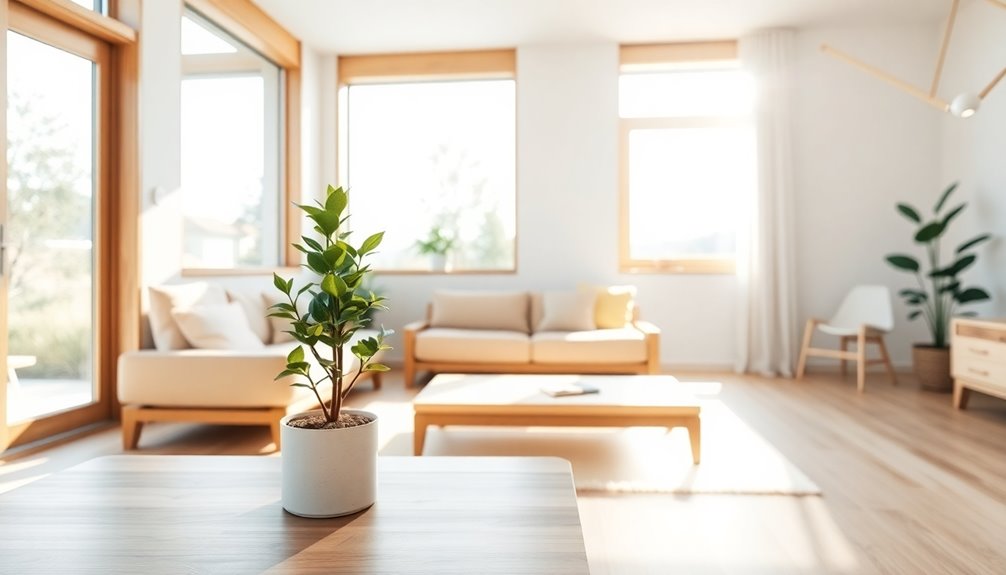
While many people embrace minimalism for its aesthetic appeal, the future of sustainable design trends reveals a deeper commitment to environmental responsibility. By focusing on minimalist plastic packaging, brands can optimize resource efficiency and reduce environmental footprints. As regulatory changes push for sustainable packaging solutions, you'll see designs that prioritize functionality and simplicity. Emerging technologies like smart packaging enhance consumer engagement while adhering to eco-friendly practices.
| Design Principle | Impact on Sustainability |
|---|---|
| Fewer Materials | Reduces waste and emissions |
| Biodegradable Materials | Supports composting efforts |
| Streamlined Aesthetics | Enhances consumer appeal |
| Smart Packaging | Engages consumers effectively |
| Minimalist Approaches | Aligns with eco-conscious choices |
Adopting these principles guarantees a greener future.
Frequently Asked Questions
How Is Minimalist Design Environmentally Friendly?
Minimalist design's environmentally friendly nature lies in its focus on efficiency and simplicity.
You use fewer materials, which means less waste and lower resource consumption. By choosing durable and functional products, you reduce the need for frequent replacements.
Minimalist packaging also cuts down on shipping costs and emissions. Plus, the clean lines make recycling easier, supporting a circular economy.
When you opt for eco-friendly materials, you're contributing to a more sustainable future.
How Does Minimalism Help the Environment?
Minimalism helps the environment by encouraging you to prioritize quality over quantity in your possessions.
By choosing fewer, multifunctional items, you reduce waste and minimize the need for replacements. You'll also notice that streamlined designs often use lighter packaging, which lowers transportation emissions.
Plus, embracing natural materials means you're supporting renewable resources.
What Is Sustainable Minimalism?
Sustainable minimalism's smart synergy simplifies your space while saving the planet.
It's all about choosing quality over quantity, allowing you to enjoy fewer, finer things that last.
By embracing eco-friendly materials like bamboo or reclaimed wood, you reduce waste and lower your ecological footprint.
This approach not only declutters your life but also fosters a deeper connection with nature, enhancing both your mental well-being and the environment.
What Is Eco Minimalism?
Eco minimalism's all about blending simplicity with sustainability. You focus on creating spaces that are functional and clutter-free, using sustainable materials like bamboo and reclaimed wood.
It encourages you to embrace conscious consumption—prioritizing quality over quantity. By opting for multifunctional designs, you not only reduce waste but also foster a deeper connection with nature.
This lifestyle promotes environmental awareness, helping you align your living space with the planet's health while enhancing your well-being.
Conclusion
As you embrace the fusion of minimalism and sustainability, you're not just transforming your space; you're nurturing the planet. Imagine a world where every item you own serves a purpose, reflecting both simplicity and eco-consciousness. By choosing this path, you're not only enhancing your own life but also paving the way for future generations. So, let your home be a canvas of mindful living, where less truly becomes more—a reflection of your commitment to a greener tomorrow.
